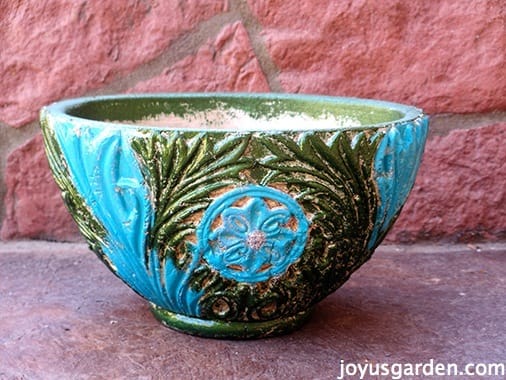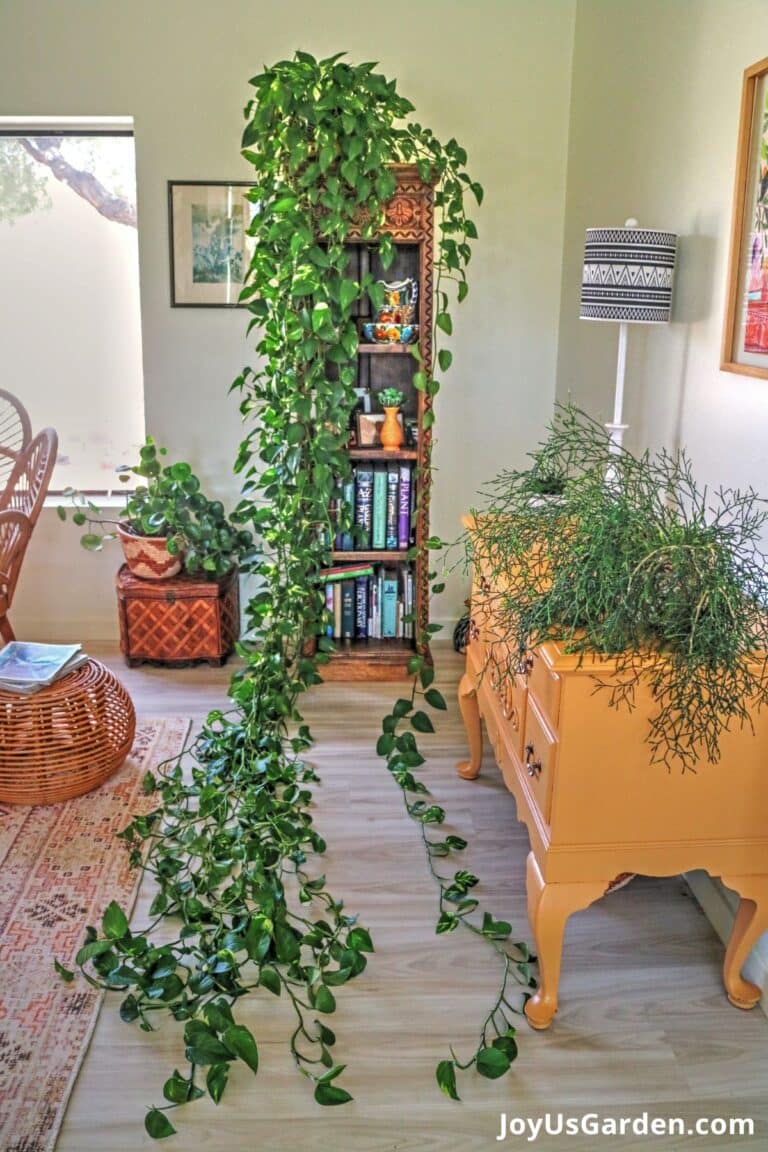Kalanchoe Care As A Houseplant & In The Garden
Oh, how I love succulents! And a succulent with lots of long-lasting flowers is just the cat’s meow. Enter the popular Kalanchoe blossfeldianas that are most commonly sold as indoor plants. In Santa Barbara, where I used to live (USDA zone 10), mine enjoyed the great outdoors year-round. This is about Kalanchoe Care indoors and outdoors, or Kals as we call them.
These long, lasting blooming plants with colorful flowers will brighten up both your garden and home. If you want the flowering period to be more long-lasting, buy your plant with at least half the flower buds partially or not yet opened. They’ll gradually open after you get them home.
I buy mine at the farmers market, and although we used them a lot in the interiorscaping trade in offices and homes, I had never grown them in the garden before. I’ve discovered that Kalanchoes bloom almost all year round here with very little care. My kind of plant!
Botanical Name: Kalanchoe blossfeldiana
Common Names: Kalanchoe, Flowering Kalanchoe, Florist Kalanchoe, Flaming Katy
NOTE: This post was published on 07/16/2014. I’m updating it on 06/22/2023. It’s one of the very first posts that I ever wrote. My how blogging has changed!
I’ve since written newer posts on Kalanchoe Care as houseplants. Rather than extensively update this post, I will list these more current posts Kalanchoe Care, Calandiva Care, and Growing Kalanchoe FAQs with more information and tips.
Kalanchoe Care In The Garden

Light Requirements
Bright shade. Mine get bright light and one or two hours of direct sun in the summer, no more. Too much direct sunlight will cause burn.
Water Requirements
Once a week, thoroughly. They’re succulents, so they like to dry out between waterings.
Soil
Mine are planted in pots in half organic potting soil and half Succulent and Cactus Mix. Kalanchoes are succulents susceptible to root rot; they must be planted in well-draining soil.
Fertilizer
I don’t use any. I plant with worm castings, then top dress with worm castings and compost every spring. Once or twice during the warm months, I’ll water in some seaweed extract.
Pests
None so far, but then they can be susceptible to mealybugs and aphids.
Pruning Tip
I trim off the spent flowers, taking the stem down to where it meets the foliage. I don’t have to do it too often because the flowers are long-lasting, and the plant looks better this way.
Kalanchoe Care As Houseplants

Now, onward to caring for them as houseplants. At the end of this post, I touch briefly on how to get them to bloom again indoors. Hint: it’s not easy.
Light Requirements
Give yours lots of bright indirect light. As bright as possible, something close to but not in a south and/or west-facing window. Keep it away from the hot windows – touching that glass will burn it. Ouch!
Water Requirements
Every two weeks in the warmer months. Wait until the soil drys out before watering again. And don’t let it sit in water. Remember, they’re succulent plants that store water in their fleshy leaves and stems, so keeping them too wet can cause mildew.
Too much moisture will also lead to root rot. They like to be kept on the dry side.
Tip: Yes, that paper or foil wrapping may be prettier than the grow pot but remove it when you water your plant. Remember, the Kalanchoe is a succulent, and too much water building up in the bottom will drown it out.
Soil
Use a potting soil mix formulated for houseplants with good drainage. A mixture of half potting soil and half Succulent and Cactus Mix would be fine. That’s what I used to plant up my new pink Kalanchoes.
Tip: Make sure the pot has drainage holes so the excess water can freely flow out.

Temperature
I say if your home is comfortable to you, then your houseplants should be just fine too. They would enjoy a vacation outdoors in the warmer months (refer to outdoor care above).
Fertilizer
Use an organic balanced liquid fertilizer like Sea Grow if you feel yours needs it. Easy does it—only two yearly applications – once in mid-spring and the other in mid-summer.
Here are some of our houseplant guides you may find helpful: 13 Stores Where You Can Buy Houseplants Online, 6 Low Maintenance Plants For Travelers, 11 Pet Friendly Houseplants, Tips For Buying Houseplants, Best Low Light Indoor Plants, Easy Care Office Plants, 7 Easy Care Floor Plants, 7 Easy Tabletop & Hanging Plants
Pests
Keep an eye out for Mealybugs. They leave behind a residue that looks like specks of cotton. Aphids and Scale can also be an issue.
Pruning Tip
The foliage grows very densely. I snip away some of those leaves growing over the blooms. Those purdy little flowers will show more!
Getting Kalanchoes To Rebloom
Now, on to how to get them to bloom again. If yours hasn’t ever repeat bloomed, don’t feel bad. I’ll start by saying “good luck” because you must work for it.
Kalanchoes, like Poinsettias, are photoperiodic. This means they react to periods of light exposure and need at least 12-14 hours of darkness to bloom again.
Chances are, if you have them in your home, you have them in a room that isn’t getting that amount of complete darkness. Starting in winter, you must put them in a closet or a pitch-black room for 12-14 hours. And yes, they need that every night for two months. Be sure to cut back on the watering too.
Kalanchoe Blossfeldiana Flower Colors
Kalanchoes are known for their beautiful flowers, which come in vibrant red, orange, and pink shades. You can also find them in white and more subtle shades of pink. There are bi-color flowers as well.
The flowers are long-lasting, and the rich green leaves are attractive and shiny. A great blooming plant for the garden or your home!



Kalanchoe Care Video Guide
(Warning: This is an old video!)
In conclusion, taking care of a Kalanchoe plant is not as daunting as it may seem. With the right light levels, water, and well-drained soil, your kalanchoe can thrive and bring life to any room in your house or the right spot in your garden.
We have written more current posts on Kalanchoes: Kalanchoe Care, Calandiva Care, and Kalanchoe FAQs with lots more information and tips.
Note: This post was originally published on 07/16/2014 and updated on 06/22/2023.
Happy Gardening,

This post may contain affiliate links, you can read our policies here.
- About the Author
- Latest Posts
Nell, the founder of Joy Us garden, was born into a gardening family and grew up in Connecticut’s countryside. After living in Boston, New York, San Francisco, & Santa Barbara, she now calls the Arizona desert home. She studied horticulture & garden design, working in the field all her life. Nell is a gardener, designer, blogger, Youtube creator, & author. She’s been gardening for a very long time & wants to share what she’s learned with you.







Hi Sadaf – My Kalanchoe is now growing indoors & blooms twice a year. I need to regularly pinch it to keep it from getting too leggy. Nell
Hello Nell. I received a plant for my birthday and couldn’t figure out what it was, until I found a tiny sticker on the bottom of the paper wrapped around the pot. Turns out it is a kalanchoe, grown in Canada and a beautiful sunny yellow – which is not a color mentioned in your article! I was looking for info on the care of it and found your website. Thanks for all the helpful information. I have this plant on the table on my screened porch – bright light, no direct sun, and happy to find that this is a great location for it. I live in southern N.Carolina and can leave it out for all but the the few cold months of the year.
Hi Kate – That’s a great location for your Kalanchoe. It’s also sheltered from frequent rains as it likes to be on the dry side. My Kalanchoes repeat bloom off & on all year so hopefully yours will too. Nell
Hello and thanks for your video. I friend gave me a few cuttings from her Kalanchoes they are in a glass with water and growing roots, when do i have to plant them in soil? I have never grown this kind of plants before. Thank you for any help.
Hi Ana – The growers routinely root kalanchoe cuttings in a propagation mix (soil less & very light). You can plant them in at any time. Nell
Hello…My kalenchoe plant has not bloomed after the first flowering and the new leaves that came after I cut the flower stalk are very tiny and not succulent and some leaves are falling off as bunch. Mine is grown completely indoors (no balcony in my apartapartment) and I water it every 3 weeks .
Hi Abida – It sounds like not enough light &/or too much water. Nell
Hi Nell: my mother brought home a kalanchoe and put it on a windowledge. within days we were over run with houseflys. Are these plants known to be an attractant for flys ?
Hi Rick – Kalanchoes, like other houseplants, aren’t an attractant to houseflies. To the best of my knowledge, they go after our food. Sounds like you might have fungus gnats (small black flies) which hatch out of the soil. This is common with houseplants. Nell
Hi Nell !! Your website is so nice. I am doing research on different types of flowers as I am writing a screenplay and your love and knowledge for flowers inspired me. One of the main characters of my script is a flower expert. May I ask you why do the Kalanchoes are known also as Neverdie? Your support will be very helpful. On the other hand, I’ve noticed some people are a bit nostalgic about this specific plant any thoughts or comments about it?
Thanks a lot!!